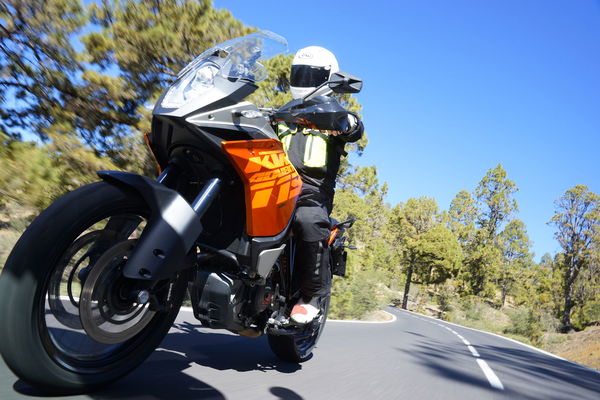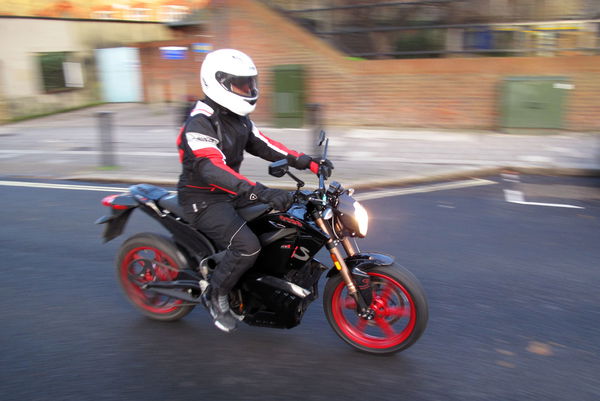First Ride: KTM 1190 Adventure review
Two-thirds of KTM's 260 technicians had a hand in the 1190 Adventure project. It's a big deal for KTM but will it be a bigger deal for the opposition?


IT'S not often you see the word ‘mayhem’ in a manufacturer’s press kit, let alone in the introduction to an adventure bike but this is KTM and those orange fellas like to do things differently.
Using the same 1195cc engine that powers the RC8R superbike, mayhem definitely sounds like it’s a mere twist of the throttle and the surrender of a skinny rear tyre away but KTM were keen to stress that even though the 1190 Adventure has the highest power to weight ratio of any bikes in this sector, outright power was never on the drawing board; more versatility was the aim and not just in the engine but across the motorcycle as a whole.
The 1190 Adventure is the replacement to the successful and cult 990 Adventure, which ceased production at the end of last year after almost 10 years. When you look at the growing list of Adventure bikes, the 990 Adventure is arguably still the best bike for the type of riding these bikes pretend they get used for: unpaved roads. So it’s ironic then that in order to sell more bikes in this class, it’s versatility not unpaved road performance that really counts.
That versatility presents itself in many ways, from the less off-road biased wheel sizes (19/17 as opposed to the 21/18 on the 990), to the 23-litre tank (19.5-litres on the 990), to the adjustable seat height and the sophisticated electronics package. The 1190 Adventure features traction control, combined ABS, power modes and optional electronically adjustable suspension, which you’d only really expect to see on a top of the range superbike.
Looks are subjective and I rarely mention them but it does appear that KTM have made an effort to make this bike whisper ‘DO YOU WANT SOME?’ and by that I mean the aggressive angular lines and the expected bright orange have been softened off somewhat. It's not quite as brash. It doesn’t look like it’s going to spit in your face.
Sat on the bike, it feels tall but not unwieldy. At 860mm, it’s no higher than the 990 but 10mm taller than the 2012 1200GS and for comparison, just 40mm taller than a CBR600RR. At 212kg wet and around 230kg fully fuelled it feels lighter than its size would lead you to believe. KTM boast it has the best power to weight ratio in its class.
The clocks are big, bold and all-digital except for an analogue rev-counter; a great combination. On the left of the rev-counter is a digital panel that gives you in-depth readouts of everything from power and damping modes, to consumption, trip, air temperature and your current position in the Dakar, probably.
You can’t fail to notice how light the clutch is. The all-new slipper clutch features a ramp-action to hold the plates in place under load, meaning lighter springs can be used which translates into a lighter lever action. Just one finger needed.
Although the motor is from the RC8, it’s undergone some serious changes both in terms of hardware and software. The 1190 Adventure’s gearbox uses different ratios to the RC8; first gear is now shorter, making clutchless low-speed control more controlled while all the ratios have been shifted away from the RC8’s 170mph top end. The pistons have been redesigned too and borrow technology used in F1, the skirts use a coating that’s designed to reduce friction and helping the engine respond quicker.
It uses Ride by Wire and not a cable throttle, so throttle inputs are measured and processed by an ECU, adding more accuracy to the calibration of fuel/air ratios. That, coupled with dual spark plugs, results in improved low-end torque, throttle response and fuel economy.
The motor is a beauty. The large 105mm piston bore and short stroke declare that this is a fast-revving engine but although it can rev, it’s not rev-happy. Load it up at 20mph in fourth gear at 2,500rpm and after a momentary strain of the power train, the rev needle heads north with steely determination.
It’s really not as savage as I thought it would be. Afterall it’s essentially an RC8 engine with more torque but the MTC traction control constantly earns its keep, keeping you safety within the limits of traction.
There are four riding modes, Sport, Street and Rain and Off-Road. The first two deliver 150bhp while the others cap power at 100bhp, the levels of traction control intervention are also adjusted. Delivery too is softened off from Sport down to Off-Road.











